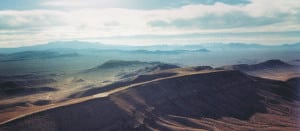
While the fiscal 2017 House Energy and Water Appropriations Bill proposes $170 million for U.S. nuclear waste activities, including $20 million for Nuclear Regulatory Commission licensing of the Yucca Mountain storage site, the Senate version does not include any funding for the national repository project.
The House spending bill, released on Tuesday, calls for $150 million to carry out the Nuclear Waste Policy Act of 1982, which designated Yucca Mountain as the site for a national repository, and $20 million for the Nuclear Regulatory Commission to continue adjudication of the Yucca Mountain license application. The money would come from the $34 billion Nuclear Waste Fund.
The House legislation also denies funding proposals that would impede adjudicatory functions, technical review, or support activities associated with Yucca Mountain licensing, or actions that “irrevocably remove the possibility that Yucca Mountain may be a repository option in the future.”
The House energy and water subcommittee on Wednesday approved the $37.4 billion bill, which is expected before the full committee next week. The Senate Appropriations Committee on Thursday approved its $37.5 billion energy and water spending proposal, which is expected on the Senate floor next week. Fiscal 2017 begins Oct. 1.
While the Senate bill was absent Yucca funding, legislators recommend $61 million for integrated waste management system activities, which would be used for work to consolidate spent nuclear fuel from around the country at interim storage facilities, with priority given to shut-down reactors.
Language in the bill introduced by subcommittee Chairman Lamar Alexander (R-Tenn.) and Ranking Member Dianne Feinstein (D-Calif.) would allow the Department of Energy to move forward with planned consolidated interim spent fuel storage sites operated by firms such as Waste Control Specialists (WCS) and Holtec International.
WCS plans to submit its Nuclear Regulatory Commission license application this month for operation of an interim storage facility in Texas, while Holtec is preparing its own license application for a similar site in New Mexico. Combined, the facilities would have the capacity to store the estimated 74,000 metric tons of commercial spent fuel that has been accumulating at American reactor sites. The Department of Energy in December formally kicked off planning for phased, adaptive, consent-based storage of spent fuel and high-level radioactive waste, which calls for operation of a pilot storage facility by 2021; one or more larger, interim facilities by 2025; and at least one permanent geologic repository by 2048. A pilot consolidated storage program, as laid out in DOE’s consent-based siting plan, is also covered under the Senate bill, according to an Appropriations Committee press release.
Alexander in a statement Wednesday called the legislation “an important step toward solving the 25-year-old nuclear waste stalemate.”
The Senate committee requested that DOE take “a more active role” in consent-based siting efforts, drawing attention to a failed borehole field test project for nuclear waste storage in North Dakota. Those plans were derailed earlier this year when the Pierce County Commission and local residents raised concern that the field test near the city of Rugby would lead to eventual storage of nuclear waste in their state. Several officials said they were not informed of the project, instead reading about it in the newspaper. The estimated $35 million project would have produced data on whether 16,000-foot boreholes drilled into crystalline rock formations are suitable for DOE-managed high-level waste. DOE and lead contractor Battelle Memorial Institute are currently searching for a new site.
“The Department cannot avoid its responsibilities of working with State and local communities by hiring a contractor to oversee and execute the work,” the bill states. “The Secretary is encouraged to ensure lessons learned from the demonstration project in North Dakota are incorporated into its plan to develop a process for future consent-based siting.”
The Obama administration’s 2017 budget proposal did not include any new funding for the Nuclear Waste Disposal program, instead laying out a funding plan meant to replace the nuclear waste deep geologic repository planned at Yucca Mountain. That plan shows $56 million in fiscal 2018 and $94 million in fiscal 2019, before increasing into the $200 million to $300 million range in the following years.